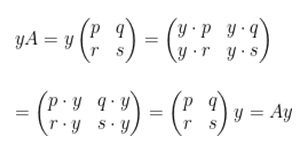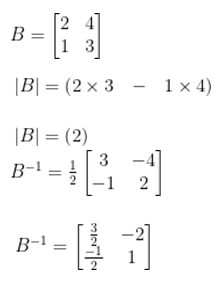Figure Matrix Tips and Tricks for Government Exams

What is matrix ?
In mathematics matrix is rectangle shape of array of number, symbol and expressions which is arranged in columns and rows. Suppose the dimension of matrix is 2 x 3
we can say two by three because there are two rows and three columns. the individual item in a matrix are called entries or elements.
The size of matrix are depend by the number of rows and columns. which is P x Q, P defined as rows and Q defined as column.
Where as single row matrix called row vectors.
Row vector: 1 x n = [4 6 9]
The matrix which contain only one column are called column vectors.
Column vector: n x 1 = 
The matrix which has same number of row and column are called square matrix.
square matrix: n x n = 
Transpose of a matrix
In transpose of a matrix where all the rows of a given matrix turning into columns and vice-versa. Suppose A is written as AT
Addition of Matrix
Addition or subtraction of a matrix are performed by adding or subtracting of corresponding elements of two given matrices. when two matrix are added or subtracted when they have the same dimension or they have the same number of row and columns. we consider of two matrices as matrices P and matrices Q.
Subtraction of Matrix

Multiplication of Matrices
- Matrix multiplication is a scalar in which a single number is multiplied with every number or entry of a matrix. In scalar matrix a number is multiplied with each number of a matrix.
- Multiplication of a entire matrix to the another entire matrix.
The first matrix is 3 x 2 which means 3 rows and two columns, and the second matrix contains 2 x 3 that is two rows and three columns. In order to multiply matrices the number of column in your first matrices has to be equal to number or rows in your second matrix. So the inside number must be the same value. In case this two number are different you can’t multiply the this two matrices. If the two value of the matrices are same then the size of the final matrices comes from the outside number, that is 3 x 3 (there rows and three columns).



- CD ≠ DC
Determinant of Matrix
In linear algebra a determinant matrix is obtained by the addition of product of the elements of a square matrix according to a given rule.
We have 3 x 3 matrix and we have some specific formula to obtain a determinant of a matrix.



What is Inverse of a Matrix?
Inverse of matrix is a matrix which change its position or swap the position.
We have written the inverse of A is A-1



|
67 videos|260 docs
|
FAQs on Figure Matrix Tips and Tricks for Government Exams
| 1. What is a figure matrix? |  |
| 2. How can I improve my performance in figure matrix questions? |  |
| 3. Are there any strategies I can use to solve figure matrix questions more efficiently? |  |
| 4. What are some common types of patterns found in figure matrix questions? |  |
| 5. Can figure matrix questions have multiple correct answers? |  |
















